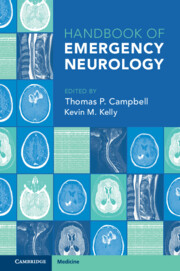Book contents
- Handbook of Emergency Neurology
- Handbook of Emergency Neurology
- Copyright page
- Contents
- Contributors
- Section 1 Neurologic Examination and Neurodiagnostic Testing
- Section 2 Common Neurologic Presentations: A Symptom-Based Approach
- Chapter 5 Coma, Delirium, and Dementia
- Chapter 6 Headache
- Chapter 7 Weakness
- Chapter 8 Musculoskeletal and Neurogenic Pain
- Chapter 9 Dizziness
- Chapter 10 Gait Disturbances
- Section 3 Specific Neurological Disorders in Emergency Medicine
- Index
- References
Chapter 9 - Dizziness
from Section 2 - Common Neurologic Presentations: A Symptom-Based Approach
Published online by Cambridge University Press: 10 January 2024
- Handbook of Emergency Neurology
- Handbook of Emergency Neurology
- Copyright page
- Contents
- Contributors
- Section 1 Neurologic Examination and Neurodiagnostic Testing
- Section 2 Common Neurologic Presentations: A Symptom-Based Approach
- Chapter 5 Coma, Delirium, and Dementia
- Chapter 6 Headache
- Chapter 7 Weakness
- Chapter 8 Musculoskeletal and Neurogenic Pain
- Chapter 9 Dizziness
- Chapter 10 Gait Disturbances
- Section 3 Specific Neurological Disorders in Emergency Medicine
- Index
- References
Summary
The evaluation of patients with the complaint of “dizziness” is a frequent occurrence in the ED. It accounts for 3.5–11% of ED visits. The word dizziness is a nonspecific term used by patients and healthcare professionals to describe a disturbed sense of wellbeing, usually perceived as an altered orientation in space. Vertigo is defined as an illusion of movement of oneself or one’s surroundings. It is usually experienced as a sensation of rotation or, less frequently, as undulation, linear displacement (pulsion), or tilt. Although vertigo usually suggests a vestibular disorder that can involve the inner ear or brain, this symptom itself cannot reliably localize the disorder. Dizziness or vertigo can result from numerous disorders of a complex human balance system. Despite the inherent complexities, the ED evaluation of dizziness or vertigo can be simplified by a systematic approach in history-taking, physical examination, and laboratory testing.
Keywords
- Type
- Chapter
- Information
- Handbook of Emergency Neurology , pp. 108 - 130Publisher: Cambridge University PressPrint publication year: 2023

